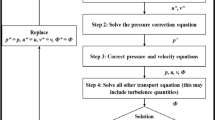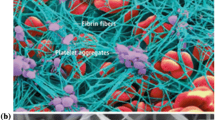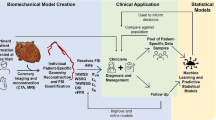Abstract
Numerous studies have provided material models of arterial walls, but limited information is available on the pseudo-elastic response of vein walls and their underlying microstructure, and only few constitutive formulations have been proposed heretofore. Accordingly, we identified the histomechanics of healthy porcine jugular veins by applying an integrated approach of inflation/extension tests and histomorphometric evaluation. Several alternate phenomenological and microstructure-based strain-energy functions (SEF) were attempted to mimic the material response. Evaluation of their descriptive/predictive capacities showed that the exponential Fung-type SEF alone or in tandem with the neo-Hookean term did not capture the deformational response at high pressures. This problem was solved to a degree with the neo-Hookean and two-fiber (diagonally arranged) family SEF, but altogether the least reliable fit was generated. Fitting precision was much improved with the four-fiber (diagonally, circumferentially, longitudinally arranged) family model, as the inability of neo-Hookean function with force data was alleviated by use of the longitudinal-fiber family. Implementation of a quadratic term as a descriptor of low-pressure anisotropy facilitated the simulation of low-pressure and force data, and the four-fiber families simulated more faithfully than the two-fiber families the physiologic and high-pressure response. Importantly, this SEF was consistent with vein angioarchitecture, namely the occurrence of extensive elastin fibers along the longitudinal axis and few orthogonal fibers attached to them and of three collagen sets with circumferential, longitudinal, and diagonal arrangement, respectively. Our findings help to establish the relationship between vein microstructure and its biomechanical response, yet additional observations are obligatory prior to endeavoring generalizations to other veins.
Similar content being viewed by others
References
Alastrué V, Peña E, Martínez M, Doblaré M (2008) Experimental study and constitutive modeling of the passive mechanical properties of the ovine infrarenal vena cava tissue. J Biomech 41: 3038–3045
Azuma T, Hasegawa M (1973) Distensibility of the vein: from the architectural point of view. Biorheology 10: 469–479
Baek S, Gleason RL, Rajapogal KR, Humphrey JD (2007) Theory of small on large: potential utility in computations of fluid-solid interactions in arteries. Comput Methods Appl Mech Eng 196: 3070–3078
Carboni M, Desch GW, Weizsäcker HW (2007) Passive mechanical properties of porcine left circumflex artery and its mathematical description. Med Eng Phys 29: 8–16
Crissman RS (1984) The three-dimensional configuration of the elastic fiber network in canine saphenous vein: A stereo scanning electron microscopic study. Blood Vessel 21: 156–170
Crissman RS, Guilford W (1984) The three-dimensional architecture of the elastic-fiber network in canine hepatic portal system. Am J Anat 171: 401–413
Demiray H, Weizsäcker HW, Pascale K (1986) A mechanical model for passive behaviour of rats carotid artery. Biomed Tech 31: 46–52
Desch GW, Weizsäcker HW (2007) A model for passive elastic properties of rat vena cava. J Biomech 40: 3130–3145
Fung YC (1993) Biomechanics: mechanical properties of living tissues. Springer, New York
Fung YC, Fronek K, Patitucci P (1979) Pseudoelasticity of arteries and the choice of its mathematical expression. Am J Physiol 237: H620–H631
Gasser CT, Ogden RW, Holzapfel GA (2006) Hyperelastic modelling of arterial layers with distributed collagen fibre orientations. J R Soc Interface 3: 15–35
Gleason RL, Dye WW, Wilson E, Humphrey JD (2008) Quantification of the mechanical behavior of carotid arteries from wild-type, dystrophin deficient, and sarcoglycan-delta knockout mice. J Biomech 41: 3213–3218
Gosline JM (1980) The elastic properties of rubber-like proteins and highly extensible tissues. Cambridge University Press, Cambridge
Gundiah N, Ratcliffe MB, Pruitt LA (2007) Determination of strain energy function for arterial elastin: experiments using histology and mechanical tests. J Biomech 40: 586–594
Han HC, Zhao L, Huang M, Hou LS, Huang YT, Kuang ZB (1998) Postsurgical changes of the opening angle of canine autogenous vein graft. J Biomech Eng 120: 211–216
Hansen L, Wan W, Gleason RL (2009) Microstructurally motivated constitutive modeling of mouse arteries cultured under altered axial stretch. J Biomech Eng 131: 101015
Hasegawa M (1983) Rheological properties and wall structures of large veins. Biorheology 20: 531–545
Hayashi K, Mori K, Miyazaki H (2003) Biomechanical response of femoral vein to chronic elevation of blood pressure in rabbits. Am J Physiol Heart Circ 284: H511–H518
Hollander Y, Durban D, Lu X, Kassab GS, Lanir Y (2011) Experimentally validated microstructural 3d constitutive model of coronary arterial media. J Biomech Eng 133: 031007
Hollander Y, Durban D, Lu X, Kassab GS, Lanir Y (2011) Constitutive modeling of coronary arterial media—comparison of three model classes. J Biomech Eng 133: 061008
Holzapfel GA, Weizsäcker HW (1998) Biomechanical behavior of the arterial wall and its numerical characterization. Comput Biol Med 28: 377–392
Holzapfel GA, Gasser CT, Ogden RW (2000) A new constitutive framework for arterial wall mechanics and a comparative study of material models. J Elast 61: 1–48
Holzapfel GA, Ogden RW (2010) Constitutive modelling of arteries. Proc R Soc A 466: 1551–1597
Humphrey JD (2002) Cardiovascular solid mechanics: cells, tissues, and organs. Springer, New York
Kitoh T, Kawai Y, Ohhashi T (1993) Effects of collagenase, elastase, and hyaluronidase on mechanical properties of isolated dog jugular veins. Am J Physiol 265: H273–H280
Kritharis EP, Kakisis JD, Giagini AT, Manos T, Stergiopulos N, Tsangaris S, Sokolis DP (2010) Biomechanical, morphological and zero-stress state characterization of jugular vein remodeling in arteriovenous fistulas for hemodialysis. Biorheology 47: 297–319
Kugelgen AV (1956) Weitere Mitteilungen über den Wandbau der grossen Venen des Menschen unter besonderer Berücksightingung ihrer Kollagenstrukturen. Z Zellforsch Mikrosk Anat 44: 121–174
Lanir Y (1983) Constitutive equations for fibrous connective tissues. J Biomech 16: 1–12
Minten J, Verheyen A, Cornelissen F, Rombauts W, Dequeker J, de Geest H (1986) Correlation between mechanical properties and wall composition of the canine superior vena cava. Arch Int Physiol Biochim 94: 349–362
Monos E, Berczi V, Nadasy G (1995) Local control of veins: biomechanical, metabolic, and humoral aspects. Physiol Rev 75: 611–666
Pasquali-Ronchetti I, Alessandrini A, Baccarani Contri M et al (1998) Study of elastic fiber organization by scanning force microscopy. Matrix Biol 17: 75–83
Rezakhaniha R, Stergiopulos N (2008) A structural model of the venous wall considering elastin anisotropy. J Biomech Eng 130: 031017
Rhodin JAG (1980) Architecture of the vessel wall. In: Bohr DF, Somlyo AD, Sparks HV (eds) Handbook of physiology, section 2: the cardiovascular system. vol 2: vascular smooth muscle. American Physiological Society, Bethesda, pp 1–31
Roach MR, Song SH (1988) Arterial elastin as seen with scanning electron microscopy: a review. Scan Microsc 2: 994–1004
Sacks MS, Sun W (2003) Multiaxial mechanical behavior of biological materials. Annu Rev Biomed Eng 5: 251–284
Sakanishi A, Hasegawa M, Dobashi T (1988) Distensibility characteristics of caval veins and empirical exponential formulae. Biorheology 25: 165–172
Sherebrin MH, Song SH, Roach MR (1982) Mechanical anisotropy of purified elastin from the thoracic aorta of dog and sheep. Can J Biochem Physiol 61: 539–545
Sokolis DP, Kefaloyannis EM, Kouloukoussa M, Marinos E, Boudoulas H, Karayannacos PE (2006) A structural basis for the aortic stress–strain relation in uniaxial tension. J Biomech 39: 1651–1662
Sokolis DP (2008) Passive mechanical properties and constitutive modeling of blood vessels in relation to microstructure. Med Biol Eng Comput 46: 1187–1199
Sokolis DP (2010) A passive strain-energy function for elastic and muscular arteries: correlation of material parameters with histological data. Med Biol Eng Comput 48: 507–518
Sokolis DP, Sassani S, Kritharis EP, Tsangaris S (2011) Differential histomechanical response of carotid artery in relation to species and region: mathematical description accounting for elastin and collagen anisotropy. Med Biol Eng Comput 49: 867–879
Takamizawa K, Hayashi K (1987) Strain energy density function and uniform strain hypothesis for arterial mechanics. J Biomech 20: 7–17
Vito RP, Dixon SA (2003) Blood vessel constitutive models—1995–2002. Ann Rev Biomed Eng 5: 413–439
Wang C, Garcia M, Lu X, Lanir Y, Kassab GS (2006) Three-dimensional mechanical properties of porcine coronary arteries: a validated two-layer model. Am J Physiol Heart Circ Physiol 291: H1200–H1209
Weizsäcker HW (1988) Passive elastic properties of the rat abdominal vena cava. Pflügers Archiv 412: 147–154
Weizsäcker HW, Holzapfel GA, Desch GW, Pascale K (1995) Strain energy density function for arteries from different topographical sites. Biomed Tech 2: 139–141
Wesley RLR, Vaishnav RN, Fuchs JCA, Patel DJ, Greenfield JC Jr (1975) Static linear and nonlinear elastic properties of normal and arterialized venous tissue in dog and man. Circ Res 37: 509–520
Wicker BK, Hutchens HP, Wu Q, Yeh AT, Humphrey JD (2008) Normal basilar artery structure and biaxial mechanical behaviour. Comput Methods Biomech Biomed Eng 11: 539–551
Xie JP, Liu SQ, Yang RF, Fung YC (1991) The zero-stress state of rat veins and vena cava. J Biomech Eng 113: 36–41
Zhou J, Fung YC (1996) The degree of nonlinearity and anisotropy of blood vessel elasticity. Proc Natl Acad Sci USA 94: 14255–14260
Zou Y, Zhang Y (2009) An experimental and theoretical study on the anisotropy of elastin network. Ann Biomed Eng 37: 1572–1583
Zoumi A, Lu X, Kassab GS, Tromberg BJ (2004) Imaging coronary artery microstructure using second-harmonic and two-photon fluorescence microscopy. Biophys J 87: 2778–2786
Author information
Authors and Affiliations
Corresponding author
Rights and permissions
About this article
Cite this article
Sokolis, D.P. Experimental investigation and constitutive modeling of the 3D histomechanical properties of vein tissue. Biomech Model Mechanobiol 12, 431–451 (2013). https://doi.org/10.1007/s10237-012-0410-y
Received:
Accepted:
Published:
Issue Date:
DOI: https://doi.org/10.1007/s10237-012-0410-y




